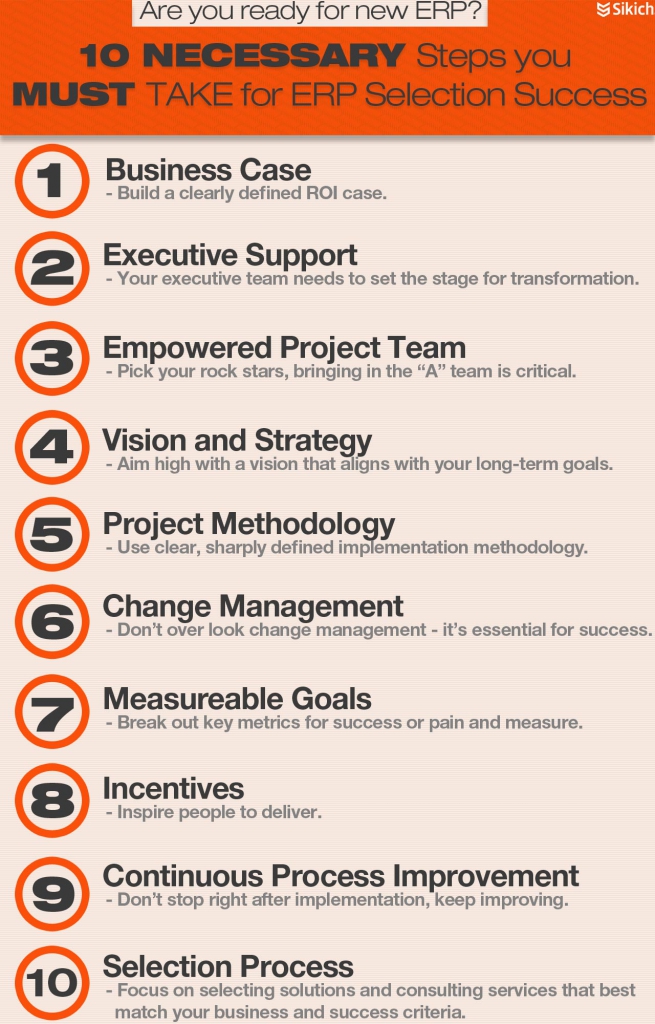This website uses cookies so that we can provide you with the best user experience possible. Cookie information is stored in your browser and performs functions such as recognising you when you return to our website and helping our team to understand which sections of the website you find most interesting and useful.
10 ERP Selection Steps You Must Take for Implementation Success

Selecting an enterprise resource planning (ERP) or business management solution is a time-consuming task and can be an expensive decision. Choosing the wrong one for your unique business could halt your company moving forward, and since 68 percent of software implementations encounter severe issues or even fail, it’s important to prepare thoroughly before selecting a solution. The key to ERP selection is not only getting educated about the ERP solution environment, but following these ten steps—in order:
- Make a business case. What drove your company to start looking for a solution? What are your objectives? What are your business needs? What do you expect the ROI to be? Although this is often the hardest internal step, you must answer these questions—and more—to understand why your company should use an ERP solution.
- Encourage executive support. This ERP process must be viewed as a business transformation initiative, not a technology project, and software is flexible enough that anyone—even non-tech employees—can use it. Thus, everyone (especially the executive team) needs to support the project and stay involved from start to completion.
- Assign a dedicated team. Figure out who in your company wants and has the capabilities to dedicate their time fully to the ERP project. Select individuals from a number of departments—logistics, marketing, finance, etc.—so that you have multiple viewpoints, and provide them resources to cover their day-to-day responsibilities, allowing them time to work on the project.
- Align your vision and strategy. Every business needs a vision and strategy—the key is to align both. Furthermore, your business processes should reflect the strategy, and the right ERP solution must have the critical functionality that allows those processes to work.
- Define project methodology. Included in your methodology should be a timeline, clear outline of responsibilities, and stops throughout the process to determine whether or not you should continue to the next step. It’s vital to plan in phases instead of the all-at-once approach.
- Execute change management. It’s one of the most overlooked areas in business, but is critical for success. There are numerous areas of organizational change management, and all are important to consider—from business process management and improvement to ERP performance measurement and optimization, among others.
- Create metrics. Without metrics, you risk not knowing down the road if the ERP solution is working or not. Put together some measurable goals—whether that’s retail sales and profits or average inventory costs—for each level and department in your organization. Remember that everything is measurable.
- Provide incentives. Inspire your employees to deliver. Show them why and how it helps them both personally and professionally. And it doesn’t have to be expensive. Rewards and promotions work as well as cash to some people—they idea is to motivate and acknowledge great work.
- Plan post-go live. Continuous process improvement can make or break your business. Your ERP solution project does not stop after you go live; in fact, the most critical benefits of ERP are achieved after implementation.
- Select your ERP solution. After you’ve gone through steps one through nine (remember, in order!), you can focus on selecting the right ERP solution. This step relies upon a number of factors. Will you outsource the research or perform in-house? What publisher are you leaning toward? Which implementation partner will work best with you? Is your infrastructure ready? These are all points to think about when selecting the software.
Although it’s a complex process, it is absolutely necessary to go through each of the steps above. If you find yourself becoming overwhelmed with all the information and different ERP solutions, or you are not sure how to get past a step, consider finding a partner to help.

This publication contains general information only and Sikich is not, by means of this publication, rendering accounting, business, financial, investment, legal, tax, or any other professional advice or services. This publication is not a substitute for such professional advice or services, nor should you use it as a basis for any decision, action or omission that may affect you or your business. Before making any decision, taking any action or omitting an action that may affect you or your business, you should consult a qualified professional advisor. In addition, this publication may contain certain content generated by an artificial intelligence (AI) language model. You acknowledge that Sikich shall not be responsible for any loss sustained by you or any person who relies on this publication.




